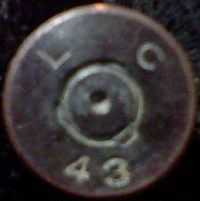Lake City Army Ammunition Plant
| Joint Munitions Command (JMC) | |
|---|---|
| Active | 2003 – present |
| Country | United States |
| Type | Major Subordinate Command of the United States Army Materiel Command (AMC) |
| Role | Operate a nationwide network of facilities where conventional ammunition is produced and stored. |
| Size | Employs 20 military, over 5800 civilians and 8300 contractor personnel |
| Colors | red, yellow, white, black, blue |
| Website |
www |
| Commanders | |
| Current commander | Brigadier General Kristin French |

Lake City Army Ammunition Plant (LCAAP) is a 3,935-acre (15.92 km2) U.S. government-owned, contractor-operated facility in northeastern Independence, Missouri, that was established by Remington Arms in 1941 to manufacture and test small caliber ammunition for the U.S. Army. The facility has remained in continuous operation except for one 5-year period following World War II.[1][2] As of July 2007, the plant produced nearly 1.4 billion rounds of ammunition per year.[3] In addition, Lake City performs small caliber ammunition stockpile reliability testing and has ammunition and weapon testing responsibilities as the NATO National and Regional Test Center.
Remington Arms operated the plant from its inception until 1985, when operations were taken over by Olin Corporation.[2] Since April 2001, it has been operated by Alliant Techsystems (ATK). LCAAP is the single largest producer of small arms ammunition for the United States Armed Forces.[3][4]
Capabilities
Capabilities of the plant include: Small arms cartridges; components such as percussion and electric primer; pyrotechnics; small caliber ammunition (5.56 mm; 7.62 mm; .50 caliber and 20 mm); performs reliability testing of small caliber ammunition (5.56 mm; 7.62 mm; 9 mm, .22 caliber; .45 caliber and .50 caliber); demilitarization and disposal of small caliber ammunition and explosives. Information Provided by the Joint Munitions Command
History
LCAAP was established in December 1940, with production beginning in 1941. It was the first of 12 small arms plants run by the Army. Information Provided by the Joint Munitions Command
Facilities
LCAAP is housed on 3,935 acres (15.92 km2) with 458 buildings, 40 igloos and storage capacity of 707,000 square feet (65,700 m2). Information Provided by the Joint Munitions Command
Hazardous waste contamination
Historically, LCAAP waste treatment and disposal occurred on-site and relied on unlined lagoons, landfills, and burn pits. The plant generated large quantities of potentially hazardous wastes and hazardous substances, including solvents, oils, greases, explosives, radionuclides, perchlorates, and heavy metals. As a result of the extensive contamination, the site has been named to the United States Environmental Protection Agency's National Priorities List.[1]
References
- ↑ 1.0 1.1 "Lake City Army Ammunition Plant Lagoon". National Priorities List. Environmental Protection Agency. 30 January 2008.
- ↑ 2.0 2.1 "Lake City Army Ammunition Plant". GlobalSecurity.org.
- ↑ 3.0 3.1 Lardner, Richard. "Ammo makers prepare for drop in demand". USA Today. 23 July 2007.
- ↑ "http://www.ammoland.com/2008/01/30/atk-continues-to-execute-a-multi-year-modernization-program/ ATK Receives $52.2 Million to Modernize the Lake City Army Ammunition Plant]". Press Release. AmmoLand. 30 January 2008.
- Information compiled from http://www.jmc.army.mil/FactSheets/FactSheets%202008/Lake%20City%20Army%20Ammunition%20Plant.pdf
External links
 Media related to Lake City Army Ammunition Plant at Wikimedia Commons
Media related to Lake City Army Ammunition Plant at Wikimedia Commons- Siekman, Mark W.; Anderson, David A.; Boyce, Allan S. (September–October 2010), "Small-Arms Ammunition Production and Acquisition: Too Many Eggs in One Basket?", Professional Bulletin of United States Army Sustainment (U.S. Army) 42 (5), PB 700-10-05. Details LCAAP production.
- Joint Munitions Command website
![]() This article incorporates public domain material from the United States Government document "Joint Munitions Command".
This article incorporates public domain material from the United States Government document "Joint Munitions Command".
| ||||||||||||||||||||||
Coordinates: 39°05′47″N 94°14′52″W / 39.09639°N 94.24778°W
